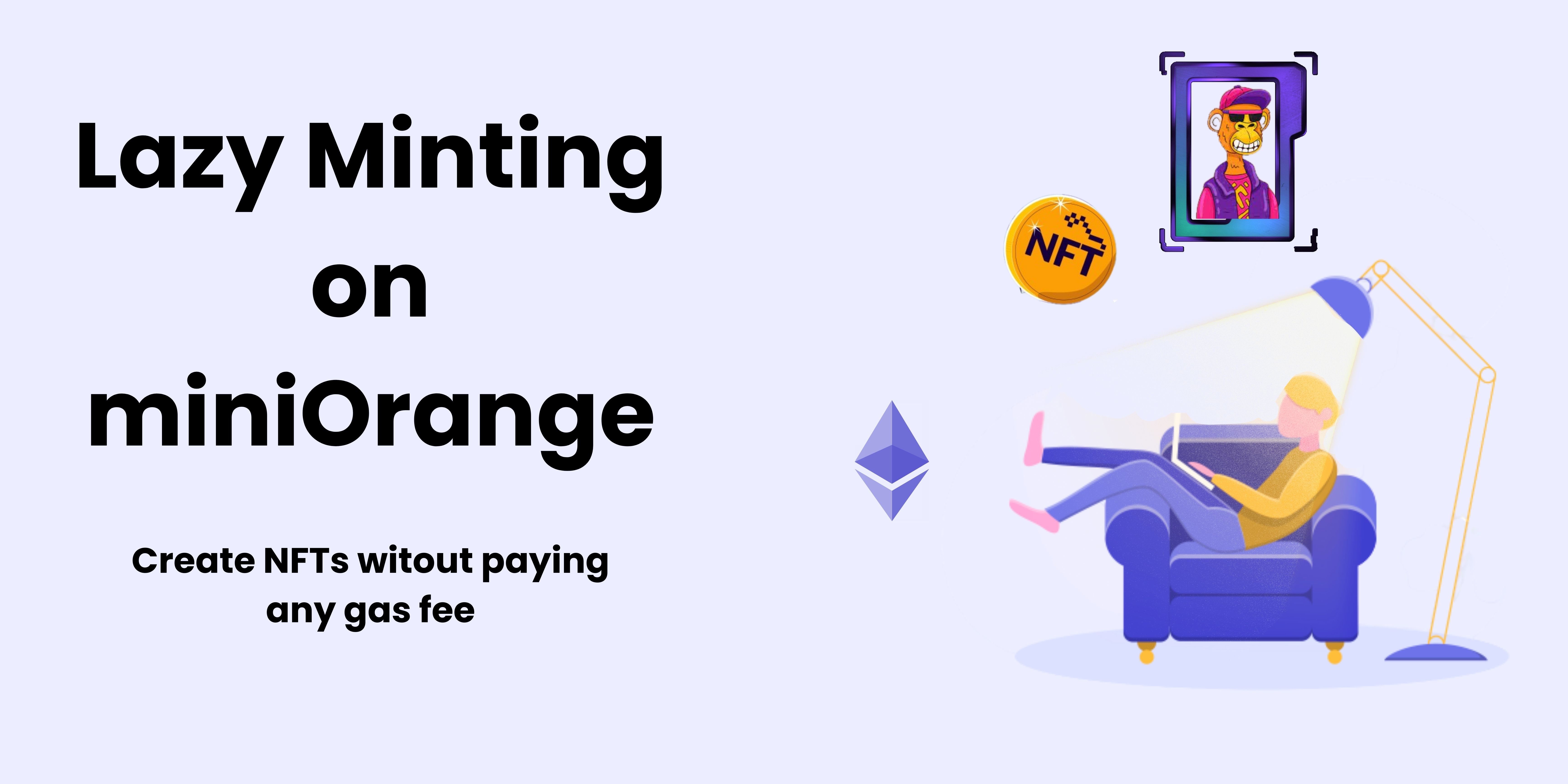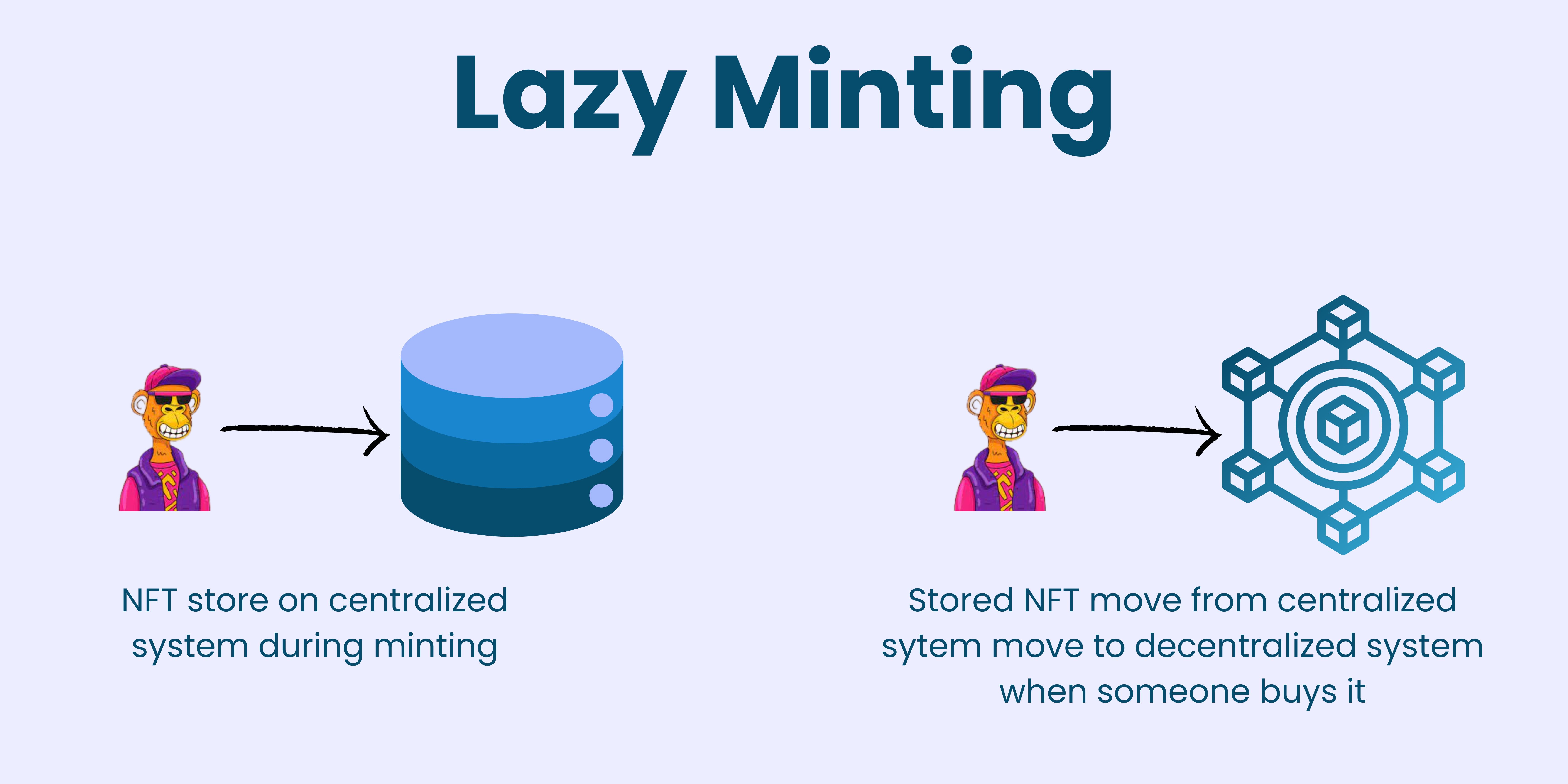
Non-fungible tokens (NFTs) are a fast-growing market, with new NFTs being minted and traded every day on the blockchain. The upfront cost of minting an NFT, however, has proven to be one of the major obstacles for creators. Typically, in order for the blockchain network to execute the transaction, creators must pay a gas fee. Particularly for aspiring creators, this can be a hefty expenditure. However, a new concept in the world of NFTs is solving this problem: lazy minting.
Lazy minting is the method of creating a non-fungible token (NFT) before it is ever sold or traded. In other words, the NFT is minted on demand after a customer displays interest in buying it, at which moment it is entirely generated.
While using lazy minting, the NFT's metadata is often prepared beforehand and kept on a blockchain. However, the creation of the token itself does not begin until a buyer is identified. This can help save on gas fees and lower the upfront costs of minting several NFTs that might not sell.
Since the NFTs market has grown, lazy minting has gained popularity as it enables creators and artists to test the market without having to invest a lot of money in minting NFTs that might not sell. By only minting NFTs when there is a genuine demand, lazy minting can also contribute to reducing the carbon footprint of NFTs.
What is NFT minting?
NFT minting is the method for creating and deploying a special digital token on a blockchain network as a non-fungible token (NFT). A person who mints an NFT effectively creates a special token that denotes ownership of a particular unique digital asset. The process for creating NFTs typically involves using a smart contract to upload details for NFTs to a blockchain network. The NFT becomes a distinct and verifiable digital token that can be bought, sold, and traded once it is minted and stored on the blockchain as an immutable token.
What is lazy minting?
Lazy minting is a technique for creating and deploying a digital token known as "non-fungible tokens" (NFT) on a blockchain in which the token is only created on the blockchain when it is sold or bought by someone. Unlike traditional minting, in lazy minting, the tokens are produced beforehand and kept in centralized storage until they are sold or transferred.
The NFT is basically minted on demand in lazy minting, which might reduce the up-front costs and dangers related to creating and storing large amounts of tokens.
In the above illustration, when some mint an NFT using lazy minting, the NFT is stored on a centralized database. And when someone comes to buy that NFT, it moves from the centralized system to the decentralized system (the blockchain). The cost of transferring the NFT will have to be paid by the buyer, which reduces the risk associated with NFT for the creator.
How does it work?
- The seller will sign a voucher using his wallet containing NFT details (e.g., NFT metadata, token ID, price, etc.).
- The voucher will be stored off-chain, which saves the gas fee for minting. The off-chain storage is centralized database storage provided by the NFT marketplace.
- when a buyer shows interest in purchasing the NFT. Then NFT will mint it on the blockchain and transfer it to his account with the help of the voucher store in the centralized storage.
Steps for lazy minting in the miniOrange NFT Marketplace?
- Go to hascoin.io and create your account.
- After logging in, go to the dashboard and deploy your smart contract.
- Then, go to Mint NFT, provide your NFT details like NFT image, metadata, price, etc., select lazy minting, and click on the List NFT button.
- A wallet pop-up will show up and ask you to sign the voucher with NFT details with your wallet address.
- After signing the voucher with your wallet, your NFT will successfully list on the marketplace.
- Whenever a buyer shows interest in buying the NFT, he will have to click on the "Buy NFT" button and pay cryptocurrency for the NFT.
- After the buyer pays for the cryptocurrency, the NFT will be minted on-chain and transferred to his wallet.
Why choose lazy minting?
- Cost savings: Creators can save money on gas fees (the cost of performing transactions on the blockchain) and storage costs by not minting all of the NFTs simultaneously. Instead, they can mint them as needed, which will save money upfront.
- Flexibility: Creators can adapt to market demands and modify their NFT products as necessary thanks to lazy minting. For instance, artists can modify a design or decide not to mint any more of it if it is not selling well.
- Reduced risk: Lazy minting reduces the possibility of excess creation and unsold NFTs, which could lead to losses for the creator. In order to reduce risk, creators should only mint NFTs when a buyer shows interest.
- Increased scarcity: Creators can make their works appear rare by only minting NFTs when someone requests them. As a result, there may be a perception of exclusivity and higher NFT demand.
- Environmental benefits: Lazy minting can help reduce the blockchain network's carbon footprint by lowering the volume of transactions processed on the blockchain.
Conclusion
In conclusion, the concept of lazy minting is an innovative solution to the challenges faced by creators and artists in the NFT market. By only minting NFTs when there is genuine demand, lazy minting can help reduce upfront costs, minimize the risk of unsold NFTs, and contribute to reducing the carbon footprint of the blockchain network. miniOrange NFT Marketplace provides a white-label NFT marketplace where you can mint your NFT through Lazy Mint. So, if you're an artist who wants to dive into the world of NFTs without paying any upfront costs, check out the miniOrange NFT Marketplace for lazy minting as a way to create and sell your NFTs for free. We can also customize the marketplace according to your needs and preferences. So feel free to drop a query for any customization you need for your marketplace. Happy minting!